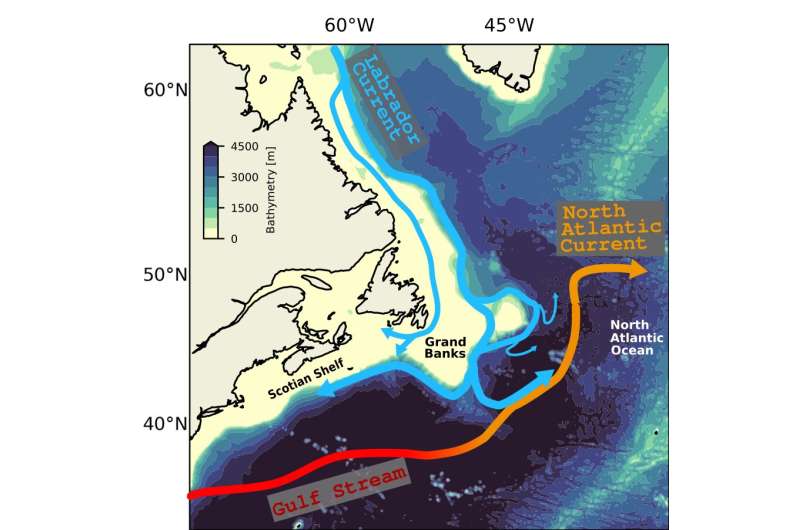This article has been reviewed according to Science X's editorial process and policies. Editors have highlighted the following attributes while ensuring the content's credibility:
fact-checked
peer-reviewed publication
trusted source
proofread
Stronger winds shift water from the Labrador Current eastward, with dire consequences for marine ecosystems

Changes to the flow of the Labrador Current along the coast of Newfoundland and Labrador to Nova Scotia are leading to sudden warmings or drops in the oxygen levels of the waters in several regions including the St. Lawrence Gulf and Estuary. This change has dire consequences for marine ecosystems and fisheries.
To better predict what could happen in the future, researchers from McGill University set out to answer the question: What controls the pathway of the Labrador Current?
Their study is published in the journal Nature Communications.
The Labrador Current supplies cold, oxygen rich waters
The Labrador Current is a cold water current in the North Atlantic Ocean that flows south along the coast of Newfoundland and Labrador, continuing partially along the east coast of Nova Scotia and partially turning eastward towards Europe. This cold water current then meets the warm waters of the Gulf Stream, which flows from the Gulf of Mexico into the Atlantic Ocean.
The Labrador Current, which flows from the Arctic Ocean, transports cold waters southwards, producing a cooling effect on the Atlantic provinces in Canada and on the United States' northeast coast from Maine to Massachusetts.
Impact on marine life as the current's pathway shifts
However, since 2008, less of the Labrador Current reaches the Atlantic Provinces and the northeast coast of the United States. "The result is less dissolved oxygen in the water, meaning species must spend more energy on respiration and less on feeding and other activities. The lower the oxygen concentrations, the smaller species like cod and halibut become," says Mathilde Jutras a Ph.D. candidate in the Department of Earth and Planetary Sciences at McGill University. "It also leads to the displacement of individuals, as they generally try to avoid hypoxic areas or where oxygen is very low."
"We want to understand why the Labrador Current sometimes veers east to feed the subpolar North Atlantic seas and other times it veers west to flow along the eastern American continental shelf, stretching from the United States' east coast to Nova Scotia," says Jutras, who studies oceanography. "When the Labrador Current goes east, we have heat waves along the American continental shelf and deoxygenation in the St. Lawrence Estuary."
Stronger winds play a role in shifting the Labrador Current east
To find answers, the team used an algorithm to track the flow and trajectories of water particles in three dimensions in an ocean simulation model. They found that the fate of the Labrador Current waters depends on a complex combination of factors.
According to the researchers, winds over the Labrador coast appear to play a role, with stronger winds veering the Labrador Current eastward. This eastward export of water is also stronger when the Gulf Stream that flows from the Gulf of Mexico comes closer to the shore, as has been the case in recent years. This happens when the Labrador Current retracts, leaving room for the Gulf Stream to shift north. The latter shift appears to also be partly driven by the winds.
"It's crucial to know where all the water ends up, since this has a significant impact on the marine life and water properties in regions where it's exported," says Mathilde Jutras. "The northward displacement of the Gulf Stream, for example, has led to the displacement of right whales towards the north, including in the Gulf of St. Lawrence, resulting in more frequent collisions with ships. These whales follow the warm Gulf Stream waters," she adds.
As next steps, the researcher plan to study what types of changes can be expected under climate change, to predict if the strong eastward shift of the Labrador Current will be maintained.
More information: Mathilde Jutras et al, Large-scale control of the retroflection of the Labrador Current, Nature Communications (2023). DOI: 10.1038/s41467-023-38321-y
Journal information: Nature Communications
Provided by McGill University




















